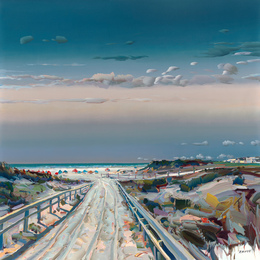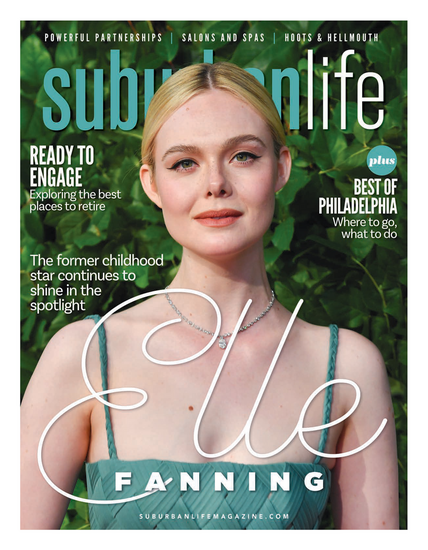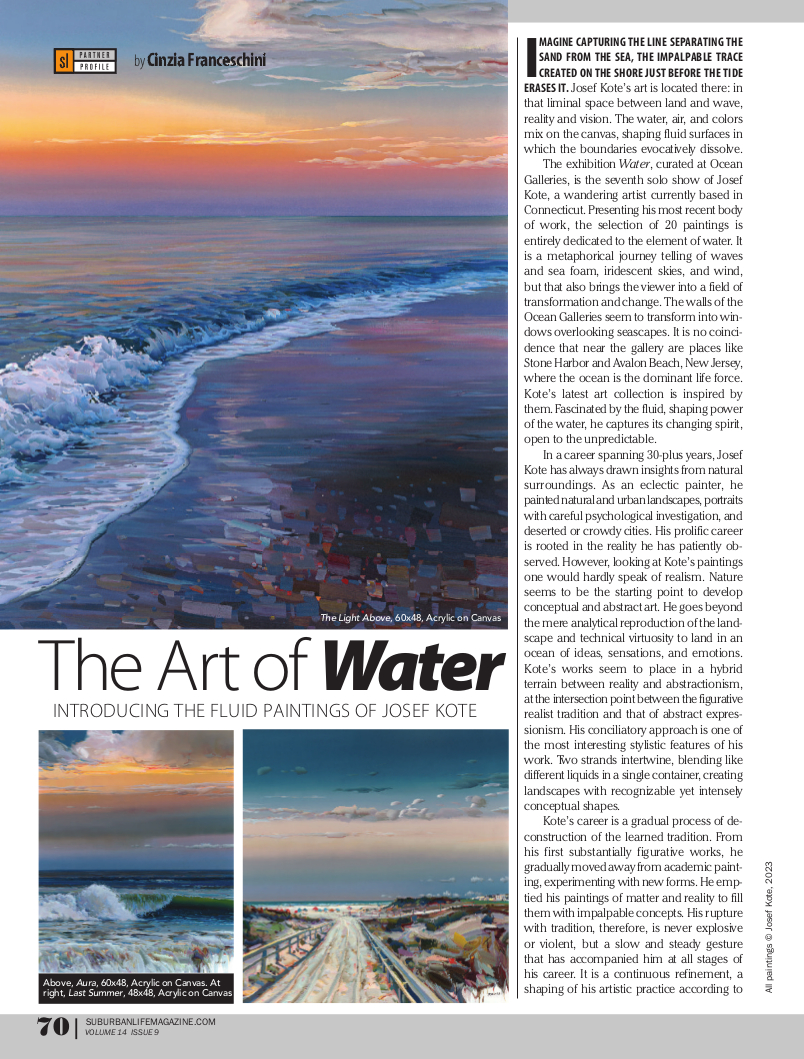
The Art of Water
Introducing the fluid paintings of Josef Kote
Imagine capturing the line separating the sand from the sea, the impalpable trace created on the shore just before the tide erases it. Josef Kote’s art is located there: in that liminal space between land and wave, reality and vision. The water, air, and colors mix on the canvas, shaping fluid surfaces in which the boundaries evocatively dissolve.
The exhibition Water, curated at Ocean Galleries, is the seventh solo show of Josef Kote, a wandering artist currently based in Connecticut. Presenting his most recent body of work, the selection of 20 paintings is entirely dedicated to the element of water. It is a metaphorical journey telling of waves and sea foam, iridescent skies, and wind, but that also brings the viewer into a field of transformation and change. The walls of the Ocean Galleries seem to transform into windows overlooking seascapes. It is no coincidence that near the gallery are places like Stone Harbor and Avalon Beach, New Jersey, where the ocean is the dominant life force. Kote’s latest art collection is inspired by them. Fascinated by the fluid, shaping power of the water, he captures its changing spirit, open to the unpredictable.
In a career spanning 30-plus years, Josef Kote has always drawn insights from natural surroundings. As an eclectic painter, he painted natural and urban landscapes, portraits with careful psychological investigation, and deserted or crowdy cities. His prolific career is rooted in the reality he has patiently observed. However, looking at Kote’s paintings one would hardly speak of realism. Nature seems to be the starting point to develop conceptual and abstract art. He goes beyond the mere analytical reproduction of the landscape and technical virtuosity to land in an ocean of ideas, sensations, and emotions. Kote's works seem to place in a hybrid terrain between reality and abstractionism, at the intersection point between the figurative realist tradition and that of abstract expressionism. His conciliatory approach is one of the most interesting stylistic features of his work. Two strands intertwine, blending like different liquids in a single container, creating landscapes with recognizable yet intensely conceptual shapes.
Kote’s career is a gradual process of deconstruction of the learned tradition. From his first substantially figurative works, he gradually moved away from academic painting, experimenting with new forms. He emptied his paintings of matter and reality to fill them with impalpable concepts. His rupture with tradition, therefore, is never explosive or violent, but a slow and steady gesture that has accompanied him at all stages of his career. It is a continuous refinement, a shaping of his artistic practice according to the places and experiences he has lived. The techniques used by Kote also reflect his desire for fluidity and synergy between tradition and abstractionism. The artist draws from both trends, blending their strengths.
A skilled performer on a technical level, Kote has refined over the years the combined use of different tools as the palette knife and the paintbrush, which have enabled him to achieve expressive results in the application of color. He also added a masterful use of dripping, a technique that involves dropping dense streams of colors onto the canvas, to freely mix them. Thanks to these processes, the textures of his paintings are bold and textural. They are rhythmic and dynamic, punctured with drops of color and pulsing across the canvas.
However, although these techniques hark back to the trend of abstract expressionism, Kote’s execution process is rooted in the academic tradition. Although energetic, his paintings are not quick or realized with superficial gestures. They are the results of studies and sketches. Kote devotes time and discipline to his art practice, working several hours per day and structuring the execution into several stages. The process often begins en-plein-air, as in the Impressionist tradition. In the outdoor phase, he gathers visual stimuli from nature, making several sketches of the surrounding landscape. It is an embryonic stage which is then elaborated later, selecting the most interesting images to explore further. Which ones to choose? The selection is, only apparently, easy. The most meaningful images are those that “remain despite the distractions of ordinary life,” those that remain imprinted in the mind even once we move away from the place of inspiration.
Kote’s artistic process is poetic, like that of the great authors who decanted landscapes. It is in the memory stage that the most powerful visions emerge. As the English poet Wordsworth wrote, in the moment of “recollecting in tranquility,” true inspiration arises. What happens next is a fruitful combination of analytical eye and intuition. From a few touches of color, the work comes to life combining seen and remembered places. Each gesture leads to an unpredictable place.
Kote is essentially a landscape artist, a painter of places transfigured by eye and mind. Even when his attention is captured by different content, as in his portrait works, the interest is always in the symbolic and emotional rendering of the subject. The Water exhibition at Ocean Galleries highlights this dual approach, this constant back-and-forth between real and abstract data. The collection devoted to the element of water is coherent with the artist's body of previous work. He creates works that exude energy and movement. Kote never paints mere landscapes, but experienced ones.
The Water exhibition shows the public yet another atmosphere, this time the glowing and vibrant view of seascapes. In some paintings, impressionistic touches of color display the chromatic variety of vegetation. As in Last Summer in which the path to the sea almost seems walkable, to feel the scent of the plants on either side, the hubbub of people on the shore. In others, the light is the protagonist, as in The Light Above in which the sunrays transform the broken shells on the shoreline into precious tiles of a mosaic, a shimmering Klimt-like background. In still other works, as in Quietude, sand and sea merge into a single element; the brushstroke of acrylic paint makes them one soft and creamy texture. Thanks to the vertical format of Silver Ripples, the foam of the waves almost looks like the ridge of a mountain. It is almost an abstract artwork. Kote also paints colorful and bright details, such as the beachgoers’ stripe umbrellas on the shore. He pays attention to formats and compositions, always making them interesting and lively.
However, the sky and the sea are the subjects where the artist gives his best. Observing the paintings in the Water exhibition, the visitor cannot remain indifferent to the dreamy cloudy skies, sometimes caught at sunset, and tinged with bright pinks and yellows, at other times laden with puffy clouds. Kote captures the sky changes, the moody and fickle aspect of New Jersey weather. He depicts the atmospheric and luminous effects, the rays of light passing through the clouds. The same attention he gives to painting the air is glaring in his depiction of ocean water: sometimes placid, a flat low tide shimmering on the shoreline; in other cases, inflated with power.
Kote’s landscapes all embody something powerful and mysterious that transcends reality. His views are inspired by precise places but at the same time they are archetypal, images that anyone can recognize. Water, air, and earth come together, creating a hybrid and organic nature. Natural elements are the real protagonists, experienced with all the senses on a synesthetic level. Water activates palpable physical sensations: the eyes move swiftly across the canvas, blinded by the light, the sea breeze blowing on the skin, and one smells the salty odor of the ocean. The painter fits into the art tendency of depicting feelings derived from a landscape rather than the landscape itself. These emotional states are often fleeting, the impression of a moment.
Kote does not perceive reality as something fixed, unchanging, to be represented with precision in all its details, but as a source of energy: an iridescent, dynamic, changing vision. This is the greatest merit of his art practice: being able to capture, brushstroke after brushstroke, the flow of events, the fluidity of the elements. Kote’s seascapes exhibited at Ocean Galleries fully demonstrate this. They are not fixed paintings, but something is moving and changing in them: the clouds passing swiftly across the sky, the water receding on the shoreline, the light shining on the waves. His seascapes look like landscapes we have seen many times before, yet they still appear undefined and new. Kote’s art practice is a continuous attempt to embody the change of nature and vision. His paintings, like water, are fluid.
We are curious to see what forms they will take in the future.
Exhibition Water
Receptions with the artist on Saturday, July 1st, and Sunday, July 2nd, at Ocean Galleries, 9618 Third Avenue in Stone Harbor, NJ 08247
(609) 368-7777
If you are unable to attend the exhibit and would like to view the artwork at home, contact jm@oceangalleries.com.
Receptions with the artist on Saturday, July 1st, and Sunday, July 2nd, at Ocean Galleries, 9618 Third Avenue in Stone Harbor, NJ 08247
(609) 368-7777
If you are unable to attend the exhibit and would like to view the artwork at home, contact jm@oceangalleries.com.
Last Summer, 48x48, Acrylic on Canvas, © Josef Kote, 2023
Published (and copyrighted) in Suburban Life magazine, May 2023.



